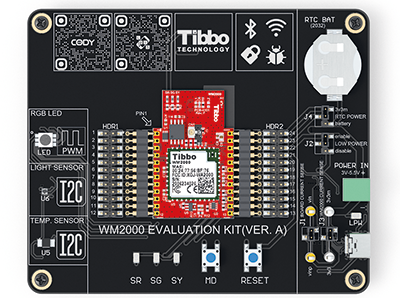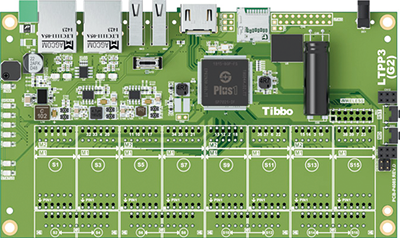
The newly released WM2000EV is an elegant kit for evaluating the capabilities of the WM2000, Tibbo’s programmable Wi-Fi/BLE module.
The kit was designed to be completely self-contained and to enable the exploration of the module’s features without having to wire in any external circuitry. To this end, the board comes equipped with all essential buttons and status LEDs, temperature and light sensors, as well as a PWM-controlled RGB LED. The included CR2032 battery (installed in a holder) can be used to test out the WM2000’s low-power ‘sleep’ mode, in which the RTC continues operating and can wake the module up at a preset time.
To aid in learning about the WM2000’s features and capabilities, Tibbo has prepared a tutorial featuring a variety of projects.
The journey begins with testing the IoT/sensor application that comes preloaded on the kit’s WM2000. By following the accompanying step-by-step guide, in as little as 10 minutes you can have the WM2000 connected to and reporting the measured temperatures and light levels to the Keen service.

The second chapter teaches you how to wirelessly upload a different application to the WM2000. This application showcases controlling the board’s RGB LED from a modern, non-reloading web page. In this step, you will also learn about the module’s ability to store two applications at once.
Further steps will explain wireless debugging, using CODY (Tibbo’s project code generator), debugging code wirelessly, connecting to Microsoft’s Azure cloud service, as well as using the WM2000 in BLE-enabled access control applications.
The kit is powered via an included USB-C cable, which can also be used as a wired debugging interface accessible from TIDE and WebTIDE software. To facilitate debugging, the board’s USB port is connected to the serial debugging pins of the WM2000 via a USB-to-serial converter IC. Wired debugging is useful when wireless debugging via Wi-Fi is unavailable or inconvenient.
Two pin headers are provided for easy access to the WM2000’s pins. The module itself is held in place by spring-loaded pins and can easily be popped out and back in. The board even features jumpers and test points for measuring the current consumption of the board and the module.
Ubuntu-based distribution for the LTPP3(G2) board
Also new, to facilitate the rapid development and deployment of Tibbo Project System (TPS)-based automation and IoT applications while offering users a familiar environment, Tibbo has created an Ubuntu-based Linux distribution. Ubuntu is one of the world’s most popular flavours of Linux. It runs on all kinds of platforms and architectures and there is a massive amount of community resources available for all project types.
Tibbo’s Ubuntu-derived distribution is ideal for system integration, one-off projects, low-volume applications, educational props and rapid prototyping of products, as well as experimentation and exploration. It provides a user experience similar to that of single-board computers such as Raspberry Pi, but on an extendable hardware foundation that was purpose-built for IoT and automation projects.

Those familiar with Ubuntu will find themselves at home on this new distribution offered by Tibbo. For example, there is a Personal Package Archive (PPA) that is accessible directly through the standard package management utility ‘apt-get’. The PPA contains several tools to help you get started with this Ubuntu-based distribution on the LTPP3(G2) as quickly and effortlessly as possible.
The LTPP3(G2) is a member of the TPS family. A popular choice for automation and IoT projects, the TPS lineup includes the mainboards, I/O modules called Tibbits and attractive enclosures. The LTPP3(G2) is a Linux mainboard designed around the company’s advanced Plus1 chip.
Included in the PPA, the Out-of-Box Experience (OOBE) script simplifies the device’s configuration with a series of interactive prompts that guide you through the process of setting up Wi-Fi/Bluetooth connectivity and the board’s Ethernet ports for pass-through or dual-port operation.
Despite its young age, the Ubuntu-based distribution is already hard at work at Tibbo’s manufacturing facility in Taipei. For example, it uses LTPP3(G2) boards for testing Tibbits during their production. Employing two high-definition cameras and a touchscreen, this system serves as the testbed for different Tibbits.
Thanks to the power of the Plus1’s pin multiplexing (PinMux), the individual I/O lines of the board can be remapped on the fly to cater to the needs of whichever Tibbit is being tested at the moment – no kernel rebuild or reboot required. On this new distribution, the board’s GPIO lines are reconfigurable in code, much like they are in a typical Tibbo BASIC application.
While this effort remains a work in progress, Tibbo has prepared a repository that contains not only the latest working image, but also automation scripts for customising builds through Docker.
| Tel: | +27 21 555 8400 |
| Email: | [email protected] |
| www: | www.rfdesign.co.za |
| Articles: | More information and articles about RF Design |

© Technews Publishing (Pty) Ltd | All Rights Reserved